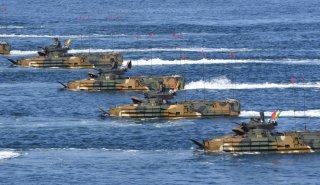The South Korean Marine Corps is Getting a New Amphibious Assault Vehicle. Here’s What We Know.
Could the Republic of Korea Marine Corps succeed where the United States Marines Corps failed?
The Korean Amphibious Assault Video II (KAAV2) is strongly reminiscent of the U.S. Marine Corps's (USMC) failed Expeditionary Fighting Vehicle. Could the Republic of Korea Marines succeed where their American counterpart failed?
Like their counterpart in the United States, the Republic of Korea Marine Corps has relied on the Amphibious Assault Vehicle (AAV) for many decades to bring Marines from ship to shore. And, like the USMC, the RoK Marines are looking for a replacement for their 1970s-era vehicle.
Korean Amphibious Assault Vehicle-II
The Republic of Korea Agency for Defense provides limited information on the Marine Corps's future vehicle. Information the Agency provides explains that the KAAV2 will be "capable of high-speed maritime operations that allow marine forces to be quickly moved from landing ships to inland target areas," and that the KAAV2 "enables marine forces to carry out cooperative operations with mechanized forces during land operations by providing mobility, firepower, and armor."
Specific information on the KAAV2 is scarce, though some details can be gleaned from models previously show at military trade shows.
One model is reminiscent of the United States Marine Corps's failed AAV replacement, the Expeditionary Fighting Vehicle (EFV). That vehicle utilized a hydraulically-actuated bow flap when in the water that helped the armored vehicle plane through the water at high 28+ miles per hour speeds. Like the EFV, the KAAV2 also has a sizeable deployable bow flap to aid in water travel.
Further aiding performance when in the water, the KAAV2 has two large-diameter water jets for propulsion. In addition, the South Korean vehicle has dual deployable side flaps that cover the underside of the vehicle's tracks and a third flap at the vehicle's rear, providing a smoother, more boat-like surface for water travel.
Dual hatches just rear of the hull's glacis and a relatively large turret top the vehicle's front. Previous reporting shed light on the KAAV2's main gun, which is large at 40mm and housed in an unmanned turret. The turret's main gun could be very effective against other armored vehicles by firing an armor-piercing fin-stabilized discarding sabot-type munition.
Postscript
Could the Republic of Korea Marine Corps succeed where the United States Marines Corps failed? Hopes were high for the USMC's Expeditionary Fighting Vehicle. On paper, the vehicle would have excelled both on land and at sea, combining the swimming abilities of a speedboat with the off-road tenacity of a tank. Unfortunately, the EFV was plagued by engine troubles and proved to be prone to breakdown. Ballooning program costs and the United States laser-focus on land campaigns axed the program.
Caleb Larson is a multimedia journalist and Defense Writer with the National Interest. He lives in Berlin and covers the intersection of conflict, security, and technology, focusing on American foreign policy, European security, and German society.
Image: Reuters

